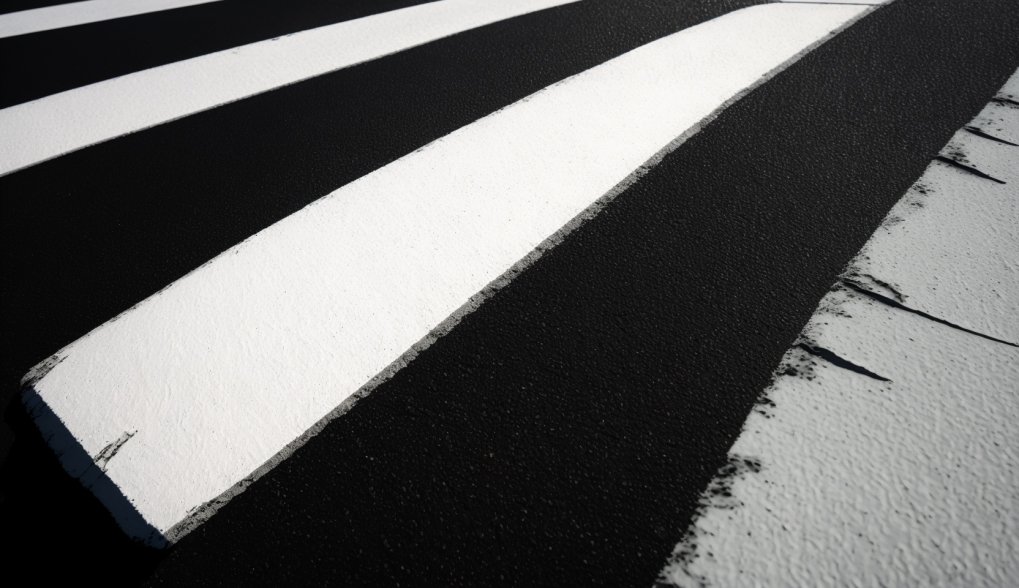Parking lot striping is an essential aspect of creating a safe, organized, and efficient parking space. In Canada, following proper guidelines and regulations ensure accessibility, compliance, and an orderly flow of traffic. This article will cover the crucial steps for a successful parking lot striping project, including planning, materials selection, surface preparation, paint application, and maintenance. We’ll also discuss the importance of adhering to Canadian standards and accessibility requirements. By following this essential checklist, you’ll pave the way to a safe and compliant parking lot that meets your goals and overcomes the challenges you may face.
Table of Contents
Introduction
Parking lots are a necessary part of our daily lives, providing a safe and organized space for vehicles. Striping is crucial to achieving this goal, as it helps to manage traffic flow, allocate spaces efficiently, and ensure compliance with accessibility requirements. A well-striped parking lot not only promotes safety but also enhances the overall appearance of your property.
Importance and benefits of parking lot striping
| Benefit | Description | Importance | Description |
|---|---|---|---|
| Improved traffic flow | Striping directs traffic and helps drivers navigate the parking lot. | Safety | Striping helps control the flow of traffic, delimit parking spaces, and pedestrian walkways, reducing congestion and increasing safety. |
| Increased safety | Clear striping can reduce the risk of accidents and improve pedestrian safety. | Compliance with regulations | Striping can help ensure compliance with ADA and other regulations. |
| Enhanced curb appeal | Freshly striped parking lots look more attractive and professional. | Aesthetics | Properly striped parking lots look more attractive and professional, which can improve the image of a business. |
| Compliance with regulations | Striping can help ensure compliance with ADA and other regulations. | Efficiency | Striping can optimize the efficiency of traffic flow, making it easier for drivers to navigate the parking lot. |
| Cost-effective | Striping is a relatively inexpensive way to improve the appearance and functionality of a parking lot. | Cost-effective | Striping is a relatively inexpensive way to ensure safety, compliance, and efficiency in a parking lot. |
Importance of parking lot striping
Parking lot striping serves several essential purposes:
- Safety: Clearly marked parking spaces, pedestrian walkways, and traffic lanes reduce the risk of accidents and collisions.
- Efficiency: Organized parking lot layouts optimize space usage and improve vehicle flow, leading to a better experience for drivers and pedestrians.
- Compliance: Proper striping ensures adherence to Canadian regulations and accessibility standards, protecting you from potential legal issues and fines.
Benefits of proper striping
Investing in high-quality parking lot striping brings several benefits:
- Enhanced curb appeal: A well-maintained parking lot creates a positive first impression for visitors, customers, or clients.
- Increased property value: An attractive and functional parking lot can increase the overall value of your property.
- Reduced liability: Proper striping minimizes the risk of accidents and injuries, protecting you from potential legal claims.
Key Takeaways:
- Parking lot striping is essential for safety, efficiency, and compliance.
- A well-striped parking lot enhances curb appeal, increases property value, and reduces liability.
Regulations and Standards
Before beginning your parking lot striping project, it’s crucial to familiarize yourself with Canadian guidelines and accessibility requirements. These standards ensure your parking lot is safe, compliant, and accessible to all users.
Canadian guidelines for parking lot striping
In Canada, parking lot striping standards vary by province and municipality. However, there are some general guidelines you should follow:
- Line width: Standard parking stall lines should be 10 cm (4 inches) wide, while accessible parking stall lines should be at least 15 cm (6 inches) wide.
- Colour: Yellow or white paint is typically used for parking lot lines, with white being more common in retail and commercial settings.
- Spacing: Stall dimensions vary by province, but a standard parking space is typically 2.7 m (9 feet) wide and 5.5 m (18 feet) long.
To ensure compliance, consult your local building codes and zoning bylaws for specific requirements in your area. The guidelines for parking lot striping in Vancouver states all signing and striping, including that for private parking lots, shall conform to the Manual of Uniform Traffic Control Devices (MUTCD).
Accessibility requirements
Accessibility is a key consideration in parking lot design. In Canada, the Accessible Canada Act sets national standards for accessibility, while provincial and municipal regulations provide additional guidance. Some general accessibility requirements include:
- Accessible parking spaces: These spaces should be clearly marked with the International Symbol of Accessibility (ISA) and located near building entrances.
- Dimensions: Accessible parking spaces should be wider than standard spaces to accommodate vehicles with wheelchair lifts or ramps. A typical accessible space is 3.7 m (12 feet) wide and 5.5 m (18 feet) long, with an adjacent access aisle of at least 1.5 m (5 feet).
- Number of spaces: The number of accessible spaces required depends on the total number of parking spaces in the lot. Consult your local regulations for specific requirements.
By adhering to Canadian guidelines and accessibility standards, you ensure that your parking lot is safe, functional, and compliant with the law.
Key Takeaways:
- Familiarize yourself with Canadian guidelines and accessibility requirements before starting your parking lot striping project.
- Consult local building codes and zoning bylaws for specific regulations in your area.
- Accessible parking spaces should be clearly marked, located near building entrances, and properly sized.
Planning Your Parking Lot Striping Project
Before diving into your parking lot striping project, it’s essential to plan and assess your lot’s current state, determine the appropriate layout, and schedule the project to minimize disruption.
Assessing the current state of your parking lot
Before you begin striping, inspect your parking lot for any issues that need to be addressed, such as:
- Faded or missing lines
- Cracks or potholes
- Inadequate signage or markings
Identify any areas that require repair or improvement to ensure a successful striping project.
Determining the appropriate layout
When designing your parking lot layout, consider the following factors:
- Traffic flow: Ensure a smooth flow of traffic by incorporating entrance and exit lanes, one-way aisles, and clear directional arrows.
- Space efficiency: Optimize space usage by selecting the appropriate parking angle (e.g., 90°, 60°, or 45°) and stall dimensions.
- Accessibility: Include the required number of accessible spaces and ensure they are properly sized and located near building entrances.
Scheduling the project
Schedule your parking lot striping project during a time when it will cause minimal disruption to users. This may include:
- Off-peak hours
- Weekends
- Holidays
Also, consider the weather forecast, as striping requires dry conditions and temperatures above 10°C (50°F) for optimal paint adhesion and drying.
Key Takeaways:
- Assess your parking lot’s current state and identify areas that need improvement.
- Consider traffic flow, space efficiency, and accessibility when designing your parking lot layout.
- Schedule your project to minimize disruption and ensure optimal weather conditions for striping.
Selecting Materials and Tools
Choosing the right materials and tools for your parking lot striping project is crucial for achieving long-lasting, high-quality results.
Types of paint
There are several types of paint that can be used for parking lot striping. These include oil/solvent-based paint, water-based paint, thermoplastic paint, and reflective paint. There are two primary types of paint used for parking lot striping: water-based acrylic and solvent-based paint. Each type has its advantages and drawbacks:
- Water-based acrylic: This paint is environmentally friendly, quick-drying, and easy to clean up. However, it may not be as durable as solvent-based paint, especially in high-traffic areas.
- Solvent-based paint: This paint is more durable and resistant to wear, making it ideal for high-traffic parking lots. However, it has a stronger odour and requires specialized equipment for application and cleanup.
Consider factors such as durability, ease of application, and environmental impact when selecting the right paint for your parking lot. For a full list of paint types.
Paint application equipment
There are several tools and equipment options for applying parking lot striping paint:
- Paint roller: A paint roller is a cost-effective option for small parking lots or touch-ups. However, it can be time-consuming and may result in less precise lines.
- Paint sprayer: A paint sprayer is faster and more efficient than a roller, but requires more skill to achieve straight, even lines.
- Line striping machine: A line striping machine is the most efficient and precise option for applying parking lot paint. These machines are designed specifically for this purpose and can save time and effort, but they can be expensive to purchase or rent.
Key Takeaways:
- Choose the right type of paint for your parking lot striping project, considering factors such as durability, ease of application, and environmental impact.
- Select the appropriate paint application equipment, weighing the benefits and drawbacks of each option.
Preparing the Surface
Proper surface preparation is crucial for a successful parking lot striping project. A clean, well-maintained surface ensures that the paint adheres properly and lasts longer.
Cleaning the parking lot
Before striping, thoroughly clean your parking lot to remove dirt, debris, and grease. Use a combination of sweeping, pressure washing, and degreasing to achieve a clean surface. This step is essential for optimal paint adhesion and a professional-looking result.
Repairing cracks and potholes
Cracks and potholes not only look unsightly, but they can also compromise the integrity of your parking lot and lead to further damage. Before striping, repair any damaged areas using asphalt patching or crack-sealing materials.
Key Takeaways:
- Thoroughly clean your parking lot before striping to ensure optimal paint adhesion.
- Repair any cracks or potholes to maintain the integrity of your parking lot and prevent further damage.
Applying the Paint
Once your parking lot surface is clean and repaired, it’s time to apply the paint. Proper paint application techniques are essential for achieving straight lines and even coverage.
Proper paint application techniques
When applying parking lot striping paint, follow these best practices:
- Use a line striping machine or paint sprayer for precise, even lines.
- Maintain a consistent speed and pressure to avoid uneven coverage or paint buildup.
- Use masking tape or a stencil to create crisp, clean edges.
Ensuring straight lines and even coverage
To achieve straight lines and even coverage, consider these tips:
- Use a chalk line or laser level to mark the location of the lines before painting.
- Practice your technique on a scrap piece of pavement or cardboard before applying paint to the parking lot.
- Work with a partner who can help guide you and ensure consistent speed and pressure during the paint application process.
Key Takeaways:
- Use proper paint application techniques to achieve straight lines and even coverage.
- Consider using tools like a chalk line or laser level to mark the location of lines before painting.
- Practice your technique and work with a partner to ensure the best results.
Maintenance and Longevity
Regular maintenance is key to ensuring the longevity of your parking lot striping. By taking care of your parking lot, you can prolong the life of the paint and maintain a safe, organized, and attractive space.
Regular cleaning
Keep your parking lot clean by regularly sweeping and pressure washing the surface. This helps to remove dirt, debris, and grease, which can wear down the paint over time.
Sealcoating
Sealcoating is a protective layer applied to asphalt surfaces, which can help to extend the life of your parking lot striping. By regularly sealcoating your parking lot, you can protect the paint from damage caused by UV rays, chemicals, and weather conditions.
Touch-ups and re-striping
Over time, parking lot lines may fade or become damaged. Regularly inspect your parking lot and perform touch-ups or re-striping as needed to maintain a safe, organized, and attractive space.
Key Takeaways:
- Regular maintenance is crucial for prolonging the life of your parking lot striping.
- Keep your parking lot clean, apply sealcoating, and perform touch-ups or re-striping as needed.
🎯 Achieving a Safe and Compliant Parking Lot
By following this essential checklist for parking lot striping in Canada, you can create a safe, organized, and efficient parking space that meets your goals and overcomes the challenges you may face. With proper planning, materials selection, surface preparation, paint application, and maintenance, your parking lot will be a valuable asset that enhances the appearance and functionality of your property.
Frequently Asked Questions
- How often should I re-stripe my parking lot?
- Re-striping frequency depends on factors such as traffic volume, weather conditions, and the quality of the paint used. Generally, it’s recommended to re-stripe every 2-4 years or when the lines have faded significantly.
- What is the best type of paint for parking lot striping?
- Both water-based acrylic and solvent-based paint have their advantages and drawbacks. Consider factors such as durability, ease of application, and environmental impact when selecting the right paint for your project.
- How long does parking lot striping paint take to dry?
- Drying time depends on factors such as paint type, temperature, and humidity. Generally, water-based acrylic paint dries within 30 minutes to 1 hour, while solvent-based paint takes longer, usually between 2-4 hours.
- Can I apply parking lot striping paint in cold weather?
- It’s not recommended to apply parking lot paint in temperatures below 10°C (50°F), as it may not adhere properly and can lead to poor results.
- How can I ensure straight lines and even coverage when applying parking lot striping paint?
- Use tools like a chalk line or laser level to mark the location of lines before painting, practice your technique on a scrap surface, and work with a partner to ensure consistent speed and pressure during the paint application process.
Sources
- “Ch. 20.945 Parking and Loading | Vancouver Municipal Code.” Vancouver Municipal Code, 2019, vancouver.municipal.codes/VMC/20.945.040. Accessed 25 Apr. 2023.
- Legislative Services Branch. “Accessible Canada Act.” Justice.gc.ca, 2019, laws-lois.justice.gc.ca/eng/acts/A-0.6/index.html. Accessed 25 Apr. 2023.
- Burdon, Judson. “Parking Lot Surface Preparation: A Step-By-Step Guide.” Asphaltkingdom.com, Asphalt Kingdom, 11 June 2018, blog.asphaltkingdom.com/parking-lot-surface-preparation. Accessed 25 Apr. 2023.
- Asphalt Paving Expert. “What Kinds of Paint Should Be Used for Parking Lot Striping? | AAA Top Quality Asphalt.” AAA Top Quality Asphalt |, 10 Mar. 2016, aaatopqualityasphalt.com/asphalt-paving-blog/what-kinds-of-paint-should-be-used-for-parking-lot-striping/. Accessed 25 Apr. 2023.










